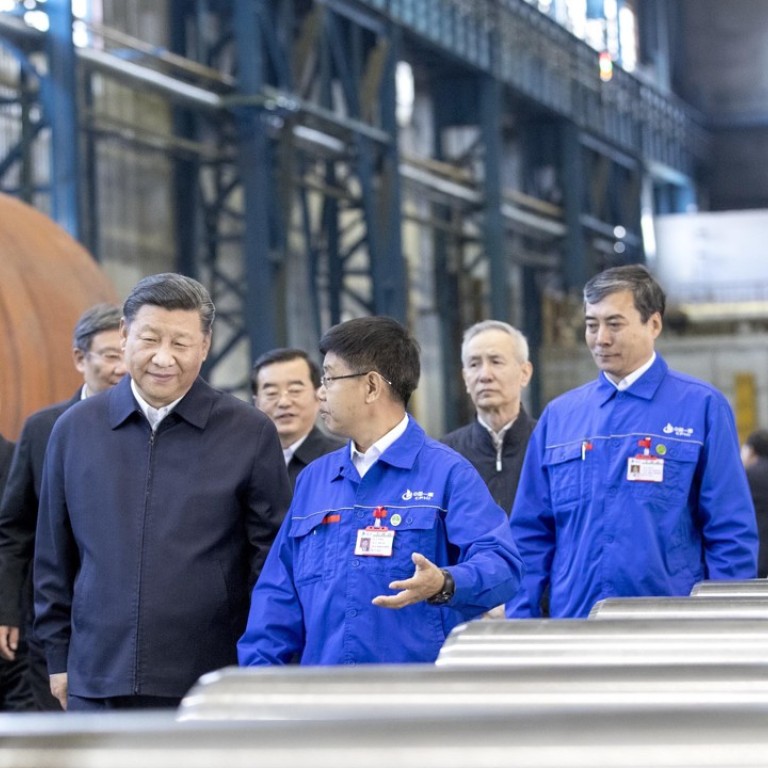
Deleveraging is the wrong way to fix China’s economy, when it doesn’t even have a debt problem
- Chen Zhao says Beijing has embraced the mistaken view that China’s economy is overleveraged. A large part of China’s high debt-to-GDP ratio is actually cheap credit given to the state sector. In fact, the private economy is underleveraged
The Chinese economy has been characterised by a stop-go pattern and policy flip-flops since 2010: a period of strengthening growth is always followed by a bout of monetary and fiscal tightening, which invariably leads to a growth slump and forces the government to reverse policy again.
The root cause of this curious economic back-and-forth is that the Chinese government has fully embraced the popular view that the economy is overleveraged. Thus, whenever business activity is strengthening, Beijing always quickly curtails credit creation to deleverage the economy, and it always backfires.

While the United States allocates 70 per cent of its financial resources via its equity markets, most Asian and European economies rely primarily on banks for financial intermediation. This means that countries with very high savings rates will have significantly higher gross debt-to-GDP ratios than economies with lower savings rates.
In fact, there is a well-defined positive correlation between the indebtedness of an economy and its savings rate. For example, Japan, Singapore and South Korea all have very high levels of debt but have also had extraordinarily high savings rates for a long time. Importantly, these economies rely primarily on commercial banks or bond markets to allocate domestic savings. As a result, these high-savings economies have all amassed very high gross debt-to-GDP ratios.
China’s savings rate is 44 per cent of GDP, which translates into nearly US$6 trillion in new savings each year that need to be transformed into investment. Since commercial banks are the main conduit for financial intermediation, it is natural for China to have a high debt-to-GDP ratio.
Some observers have pointed out that China’s debt-to-GDP ratio has not not always been rising. Prior to 2008, there was a period when the rate was quite flat; only since 2009 has the ratio escalated. They see the escalating ratio as a sign that China’s debt creation has become much less efficient in generating GDP.

Second, Chinese state monopolies, although dressed up as business ventures, are actually government agencies that carry out Beijing’s various policy initiatives. In return, they receive cheap credit from state-owned banks as implicit subsidies. In fact, most “credit” extended to state-owned enterprises should be reclassified as Beijing’s fiscal outlays. Therefore, a large portion of China’s rising credit-to-GDP ratio is in fact public-sector liabilities.
Finally, we cannot ignore a broad global backdrop. There has been a structural breakdown in both money multipliers and interest rates around the world. Interest rates reflect both the expected rate of return on capital and the price of credit. A structural fall in interest rates, in and of itself, means that the steady-state economic growth rate is lower globally, and that a larger amount of credit creation is needed to generate the same amount of output, or GDP, in the post-2008 world. In other words, rising total indebtedness is a global phenomenon, not a China-specific trend.
All of this means that the debt-to-GDP ratio is a poor, even misleading, measure of whether an economy is over- or underleveraged, or facing increasing systemic risk. Debt crises have erupted in countries with low debt-to-GDP ratios – for example, Russia in 1998 and Turkey in 2000.

The Chinese government needs to understand that curtailing credit creation is the wrong way to deleverage the economy. By disallowing credit growth, the monetary authorities effectively choke off credit flows in the economy, creating financial disintermediation. The consequence of such a policy is that a portion of national savings cannot be transformed into capital investment. The natural result of this financial disintermediation is a drop in real output, price levels, or some combination of both. In my view, the true culprit behind China’s stop-go economy is Beijing’s policy of deleveraging.
The Chinese government should switch from attacking leverage to introducing true supply-side reforms, which would include cutting taxes, privatising state monopolies and liberalising the financial system. It seems the People’s Bank of China is taking measures to encourage commercial banks to make loans to small and medium-sized private companies. This is a step in a right direction, but much more has to be done.
And if policymakers still feel a need to watch the debt-to-GDP ratio, they should keep in mind that the most effective way to bring down the ratio is to expand GDP, the denominator, rather than cut down debt, the numerator. Cutting down debt will cause GDP growth to drop, producing an even higher debt-to-GDP ratio. However, focusing on expanding GDP can bring down the debt ratio quickly. Mathematically, this just makes more sense.
Chen Zhao is founding partner and chief global strategist at Alpine Macro. [email protected]

